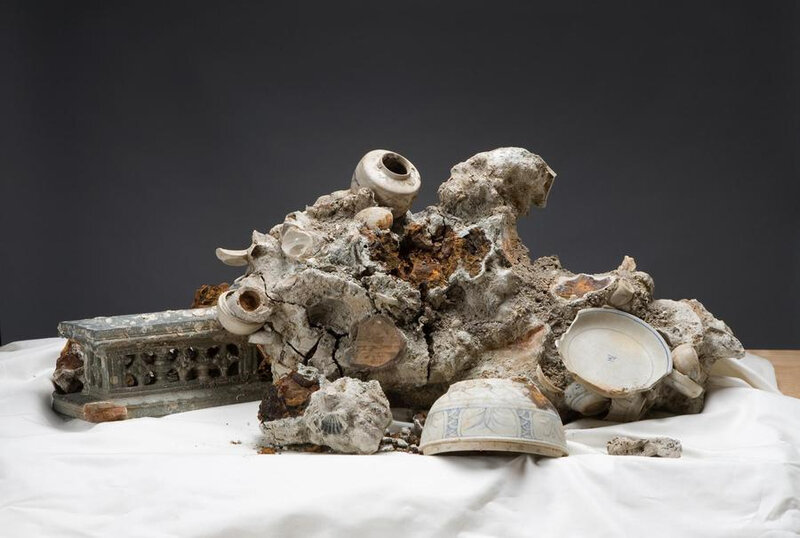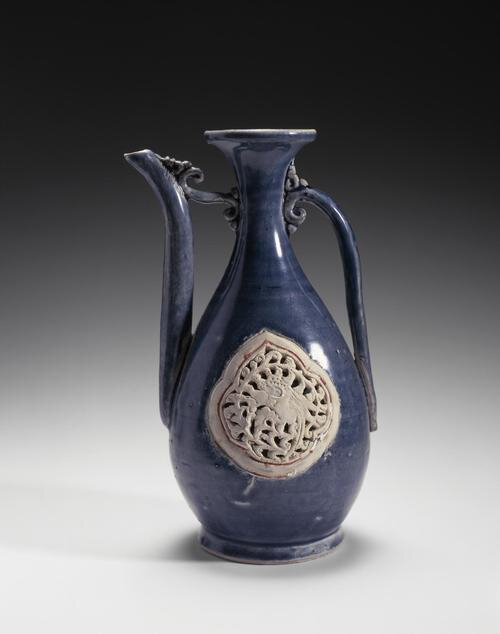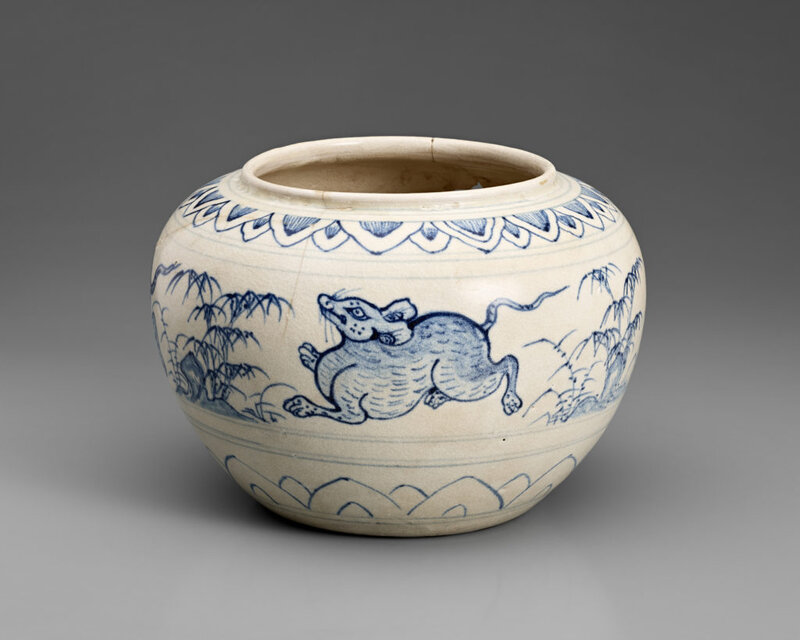Asian Art Museum presents historic Vietnamese art recovered from shipwrecks
Architectural element with a multiheaded mythical serpent, approx. 1150–1250. Vietnam; Binh Dinh province, former kingdoms of Champa. Stone. Asian Art Museum, Gift of Richard Beleson in honor of Hanni Forester , 2012.103. Photograph © Asian Art Museum..
SAN FRANCISCO, CA.- A fierce three-headed serpent and a mysterious female deity were among the nearly two dozen 12th-century stone sculptures from Central Vietnam that lay unseen at the bottom of the Arabian Sea for nearly 120 years. Almost 5,000 miles away in the South China Sea, blue-and-white ceramic bowls, plates and jars rested in the hold of a sunken ship off the coast of Vietnam for more than five centuries. Preserved like time capsules under the seas, these shipwrecks contained artworks that were excavated in the 1990s by marine archaeologists, sold at auction, purchased by individual collectors and then donated to the museum.
From Nov. 26 2019-Mar. 22, 2020, Lost at Sea: Art Recovered from Shipwrecks offers visitors a chance to go behind the scenes and trace the pathways of these objects, from Vietnam to the ocean floor to San Francisco. “We want our audiences to ask questions about how artworks enter museum collections,” says Natasha Reichle, exhibition organizer and Asian Art Museum assistant curator of Southeast Asian art.
“What does the provenance of an object reveal? What can art salvaged from the sea tell us about trade and the colonial enterprise? Who is entitled to centuries-old artworks recovered from shipwrecks? Should they even be excavated, or should vessels and their contents be left in situ for future generations?”
Ceramics on display are from a trading vessel that sank in the 15th century off Vietnam’s Hoi An coast with a cargo of more than 250,000 objects originally made for export. After fishermen began to find porcelain shards in their nets in the 1990s, a government-sanctioned commercial salvage operation brought up the cache, dubbed the Hoi An Hoard.
Concretion of ceramics, approx. 1450–1500. Vietnam. Stone, antler, shell, corroding iron, and remains of sea creatures. Asian Art Museum, Acquisition made possible by Betty and Bruce Alberts, Will and June Arney Roadman, Annie and Cameron Dorsey, Jean and Lindsay MacDermid, Rhoda Stuart Mesker, and Ann Witter, 2000.31. Photograph © Asian Art Museum.
Pouring vessel with openwork panels, approx. 1450–1500. Northern Vietnam; Chu Ðậu. Stoneware with glaze and traces of enamel and gilding. Asian Art Museum, Acquisition made possible by Peg Dueringer, Dr. and Mrs. Vincent Fausone Jr., Nora Norden, Dr. and Mrs. Stephen Sherwin, Mr. and Mrs. M. Glenn Vinson Jr., and Mimi Truong Wall, 2000.30. Photograph © Asian Art Museum.
Blue-and-white jar, approx. 1450–1500. Northern Vietnam; Chu Ðậu. Stoneware with cobalt decoration under glaze. Asian Art Museum, Gift of David and Mary Bromwell, 2010.492. Photograph © Asian Art Museum.
Fragmentary dish with design of a winged horse, circa 1450–1500, Northern Vietnam. Stoneware with cobalt decoration under glaze. Asian Art Museum, Gift of David and Mary Bromwell, 2010.492. Photograph © Asian Art Museum.
The stone sculptures, relics of the Cham culture that thrived along the coast of Central Vietnam from the 5th to the 15th century, had been carted off from a ruined temple by a French colonial officer in the 19th century. The two works in the museum collection are from a group of 21 that were on their way to France when the steamer they were on sank off the coast of Somalia in 1877. The passengers and crew were saved, but the stone sculptures, apparently too heavy to transport to shore, were left in the wreckage. They were finally retrieved in 1995.
Architectural element with a multiheaded mythical serpent, approx. 1150–1250. Vietnam; Binh Dinh province, former kingdoms of Champa. Stone. Asian Art Museum, Gift of Richard Beleson in honor of Hanni Forester , 2012.103. Photograph © Asian Art Museum..
The exhibition brings together artifacts from these two shipwrecks, including a slowly disintegrating concretion of objects from the Hoi An Hoard, along with maps and other materials that invite consideration of how artworks travel across time and cultures.
“Shipwrecks open portals to the past and offer us new ways to encounter and think about amazing art from centuries ago,” says Jay Xu, director and CEO of the Asian Art Museum. “The art we find underwater showcases all sides of what our museum does best—from collecting, to contextualizing, to conserving. Lost at Sea is a uniquely layered experience that connects us to an unexpectedly broad story, a story only we can tell."

/https%3A%2F%2Fprofilepics.canalblog.com%2Fprofilepics%2F1%2F0%2F100183.jpg)
/https%3A%2F%2Fstorage.canalblog.com%2F03%2F02%2F119589%2F96711876_o.jpg)
/https%3A%2F%2Fstorage.canalblog.com%2F11%2F31%2F119589%2F94773502_o.jpg)
/https%3A%2F%2Fstorage.canalblog.com%2F20%2F83%2F119589%2F94772815_o.jpg)
/https%3A%2F%2Fstorage.canalblog.com%2F26%2F72%2F119589%2F75604929_o.jpg)
/https%3A%2F%2Fstorage.canalblog.com%2F59%2F60%2F119589%2F26458628_o.jpg)









/image%2F1371349%2F20240425%2Fob_c453b7_439605604-1657274835042529-47869416345.jpg)
/image%2F1371349%2F20240425%2Fob_59c6f0_440358655-1657722021664477-71089985267.jpg)
/image%2F1371349%2F20240425%2Fob_07a28e_440353390-1657720444997968-29046181244.jpg)
/image%2F1371349%2F20240425%2Fob_0b83fb_440387817-1657715464998466-20094023921.jpg)